ISSN ONLINE(2319-8753)PRINT(2347-6710)
ISSN ONLINE(2319-8753)PRINT(2347-6710)
Suresh.G1, Vignesh.R1, Aravinth.B1, Padmanabhan.K1, A.Thiagararajan2
|
| Related article at Pubmed, Scholar Google |
Visit for more related articles at International Journal of Innovative Research in Science, Engineering and Technology
The composite materials have more elastic strain energy storage capacity and high strength to weight ratio as compared with those of steel, so conventional helical coil springs are being replaced by composite cylindrical helical coil springs. This project describes design and experimental analysis of composite helical spring made of fiber reinforced polymer of Woven Roving Fiber (WRF), and Thermo set polymer (Epoxy Resin) with Nano clay (Garamite). The addition of nanoclay provides unique mechanical and tribological properties combined with low specific weight and a high resistance to degradation in order to ensure safety and economic efficiency. A comprehensive study was carried out a series of Nano composites containing varying amount of nano particles (Nano clay). The objective is to compare the load carrying capacity, stiffness and weight savings of composite helical spring with that of steel helical spring. The design constraints are stresses and deflections. The dimensions of an existing conventional steel helical spring of a light commercial vehicle are taken. Same dimensions of conventional helical spring are used to fabricate a composite spring.
Keywords |
| Composite helical springs, Spring Constant, Glass Fiber, Epoxy, Garamite, Spring rate. |
INTRODUCTION |
| A. Suspension Springs |
| Springs are crucial suspension elements on automobiles which are necessary to minimize the vertical vibrations, impacts and bumps due to road irregularities and create a comfortable ride. Coil springs are commonly used for automobile suspension and industrial applications. The fuel efficiency and emission gas regulations of automobiles are two important issues in these days. The best way to increase the fuel efficiency is to reduce the weight of the automobiles by employing composite materials in the structure of the automobiles. Metal coil springs can be replaced by composite springs because of weight reduction and corrosion resistance. Metal coil springs cannot withstand high temperature. At high temperature where it is required to operate composite springs are used. Metal springs have several advantages, they are very cheap to produce and can be produced in almost all kinds of measures and in a very broad range of stiffness. Since the composite materials are anisotropic in nature, the design and manufacture of composite springs are difficult. Therefore the application of composite materials in springs is not yet popular. However they are used in the suspension system of the automobiles. |
| For the purpose of saving energy and improving the performance of the shock absorbers, with light weight and high quality, composite materials have to be used for today’s vehicles. With the more no of electric vehicles and hybrid vehicles are entering into the market in the present scenario, it has become essential to go for the light components for improving the efficiency. |
| Because composite springs have some advantages over the metal springs, many researchers are actively involved in the study of composite springs. They have made the springs with different material structures like, unidirectional laminates, rubber core unidirectional laminates, unidirectional laminates with a braided outer layer, and rubber core unidirectional laminate with a braided outer layer. |
| The literature survey has revealed that, only prototype composite springs were prepared and tested for the performance. Since the time consumed for the manufacturing of the composite springs is more, the standard and simple method of mass production of composite coil springs is required from the economical point of view. |
| In this study a spring from the two wheeler is taken for replacement. Glass fiber are used for the manufacture of composite coil springs. The principal advantage of fiber reinforced polymer matrix composites for automobile parts is weight savings, part consolidation, and improvement in NVH (noise, vibration and harshness). The absence of corrosion problems, which lowers maintenance cost for automobile parts, enables the use of fiber reinforced polymeric composite. |
| Three types of springs were manufactured in this study with Woven Roving Fiber (WRF) and Thermoset polymer (Epoxy Resin) and Nano clay (3 different compositions).These springs were tested for spring rate and other parameters. The results show the feasibility of composite springs for light vehicle applications. |
| B. Composite Materials |
| A composite material is one in which two or more materials that are different are combined to form a single structure with an identifiable interface. The properties of that new structure are dependent upon the properties of the constituent material as well as the properties of the interface. In the more familiar world of metals, the mixing of different materials typically forms bonds at the atomic level, composites typically forms molecular bonds in which the materials retain their identity and mechanical properties. Where the metal alloys have isotropic characteristics. Composites have very selective directional properties to meet specific application needs. So composites are highly targeted engineering material consists of two or more distinct phases one ii matrix phases and another is dispersed phases. |
| Matrix phases |
| The primary phases having a continuous character is called matrix. It holds the dispersed phases and shares the load with it. |
| Dispersed phases |
| The second phase is embedded in the matrix in a discontinuous form. This phases is usually stronger than matrix phase therefore it is called reinforcing phase. |
| C. Needs of The Composites |
| Light weight |
| Higher Operating Temperature |
| Greater Stiffness |
| Higher Reliability |
| Affordability |
| D. Polymer Matrix Composites |
| Advanced composites exhibit desirable physical and chemical properties that include light weight coupled with high stiffness and strength along the direction of the reinforcing fiber, dimensional stability, temperature and chemical resistance, flex performance, and relatively easy processing. Advanced composites are replacing metal components in many uses, particularly in the aerospace industry. |
| Resins |
| The resin systems used to manufacture advanced composites are of two basic types: thermosetting and thermoplastic. Thermosetting resins predominate today, while thermoplastics have only a minor role in advanced composites manufacture. |
| Thermosets |
| Thermoset resins require addition of a curing agent or hardener and impregnation onto a reinforcing material, followed by a curing step to produce a cured or finished part. Once cured, the part cannot be changed or reformed, except for finishing. Some of the more common thermosets include: |
| Epoxies |
| Polyurethanes |
| Phenolic and amino resins |
| Bismaleimides |
| Polyamides |
| Thermoplastics |
| Thermoplastics currently represent a relatively small part of the PMC industry. They are typically supplied as nonreactive solids (no chemical reaction occurs during processing) and require only heat and pressure to form the finished part. Unlike the thermosets, the thermoplastics can usually be reheated and reformed into another shape, if desired. |
| E. Process Material |
| The materials used to process the nanocomposites are Epoxy, and Nano clay of Garamite is the matrix material. Woven roving mat is used as reinforcement. Matrix phases |
| Nano clay, Epoxy Resin |
| Dispersed phases |
| Glass reinforcement |
| fiber of Woven Roving |
| Mat |
| F. Reinforcement |
| Fiber reinforcement materials are added to the resin system to provide strength in the finished part. The selection of reinforcement material is based on the properties desired in the finished product. These materials do not react with the resin but are an integral part of the advanced composite system. |
| 1) Types Of Reinforcement |
| Three basic types of fiber reinforcement materials in use in the advanced composite industry are: |
| Carbon/graphite |
| Aramid |
| Glass fibers |
| Fibers used in advanced composite manufacture come in various forms, including: |
| Yarns |
| Roving |
| Chopped strands |
| Woven Roving Mat |
| 2) Woven Roving Mat |
| Woven roving is a course, heavy fabric made of long, continuous strands of glass fibers. They are typically used in alternate layers with chopped strand mat to form the structural layer of a vessel. The resulting laminate will be about 40-50% glass. |
| 3) Properties Of Woven Roving Mat |
| High strength and modulus |
| Temperature stability |
| Flex performance |
| Dimensional stability |
| Chemical resistance |
| Low density |
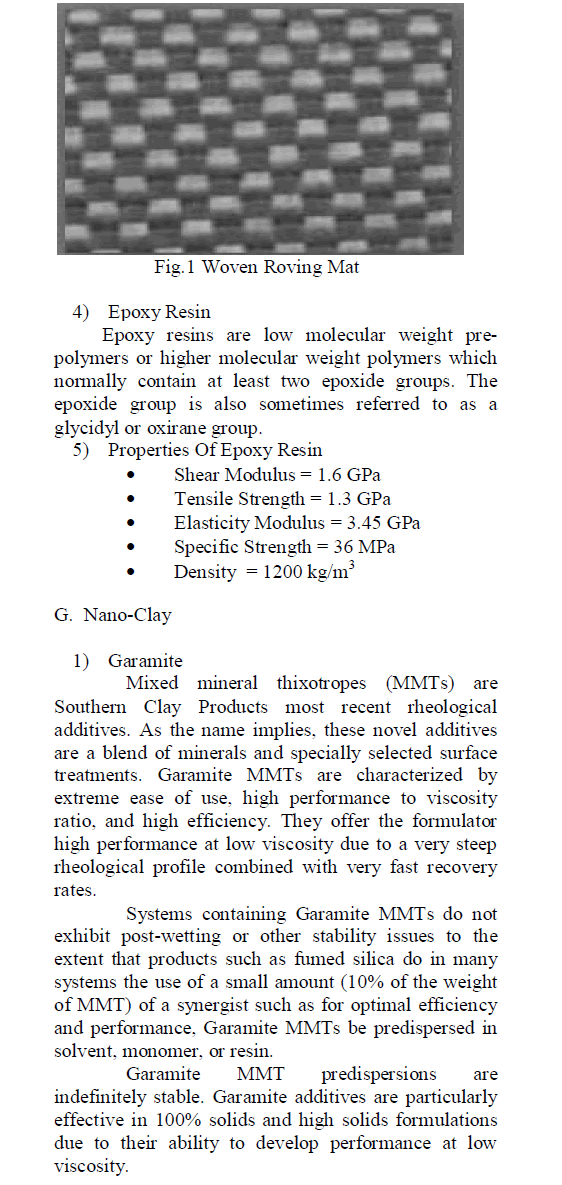 |
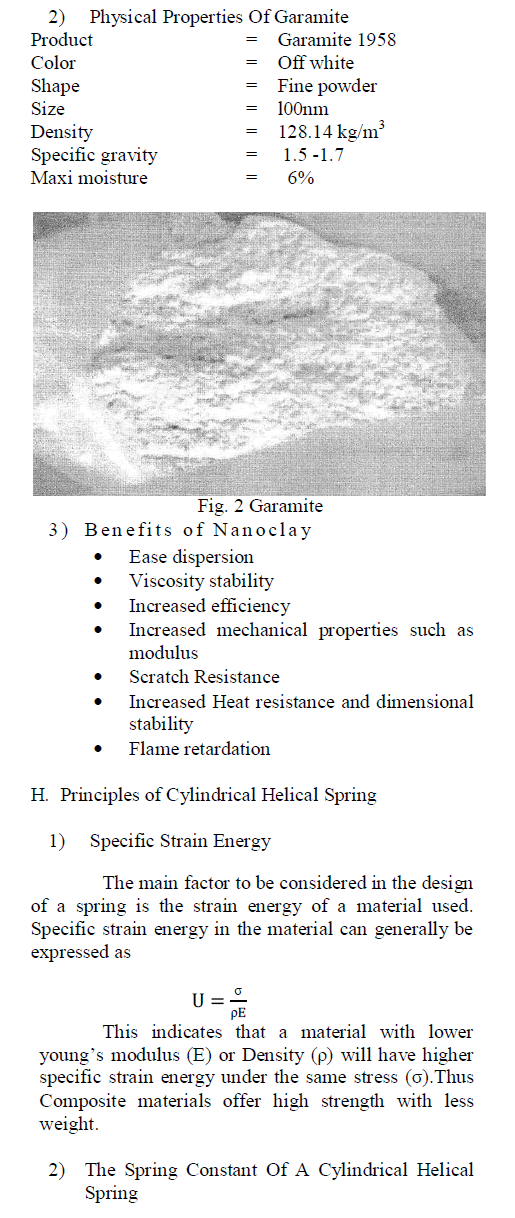 |
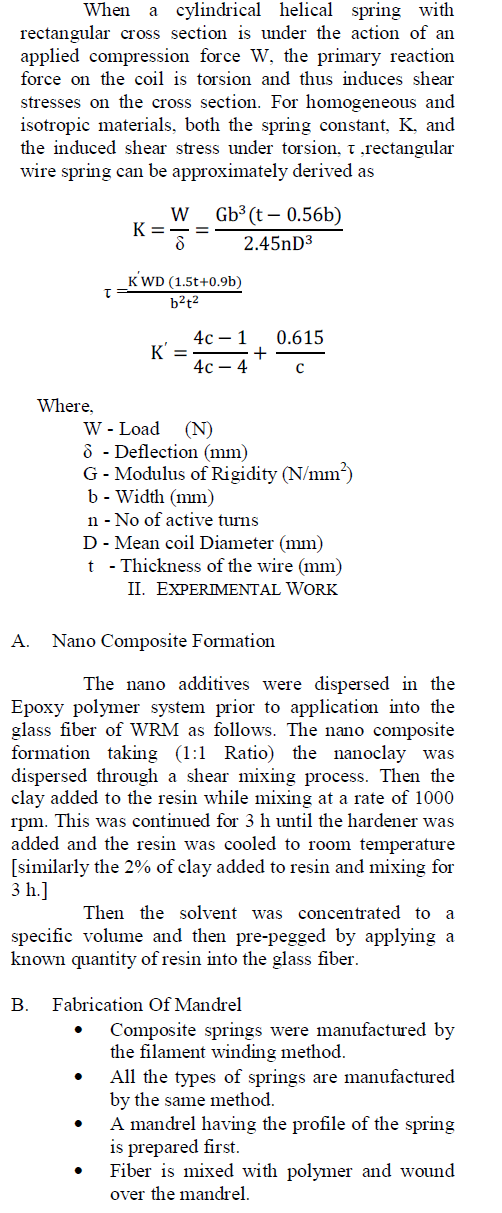 |
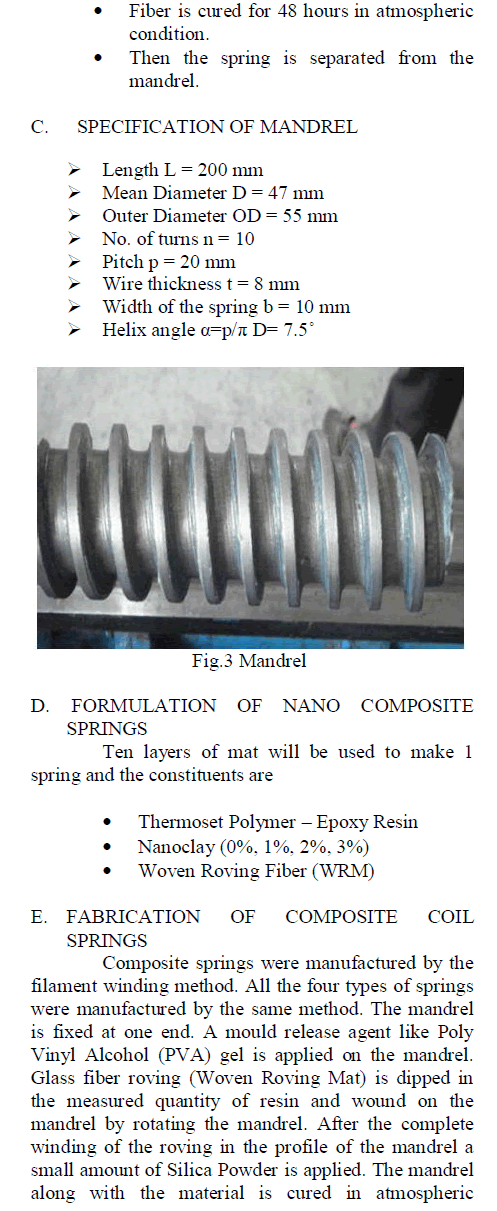 |
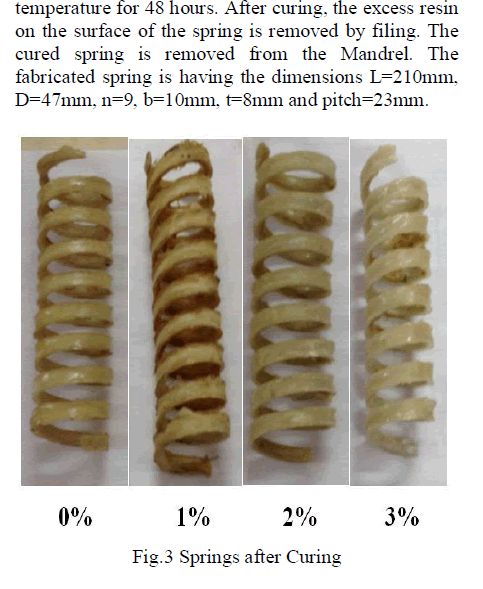 |
CONCLUSIONS |
| The types of composite coil springs have been developed in this study; they are lighter than steel spring and the stiffness achieved in these springs are less than the steel spring. |
| As compared to steel springs of the same dimensions, the stiffness of composite coil springs is less. In order to increase the stiffness of the spring the dimensions of the composite spring is to be increased which in turn increases the weight of the spring. Hence the application of the composite coil springs can be limited to light vehicles, which requires less spring stiffness, e.g. electric vehicles and hybrid vehicles. |
| The manufacturing of the composite coil springs is also difficult and time consuming compare to steel spring, however with the use of CNC winding machine and automated process which can be made easy and also the manufacturing cost can be reduced if produced in mass. |
ACKNOWLEDGMENT |
| We are very thankful and grateful to our Department Head Dr.K.Velmurugan, Co-ordinator Mr.G.B.M.Mohanraj, and our beloved sister Ms.K. Krishnapriya whose great support, valuable advices, suggestions and tremendous help enabled us in completing our project. They have been a great source of inspiration to us. |
References |
|